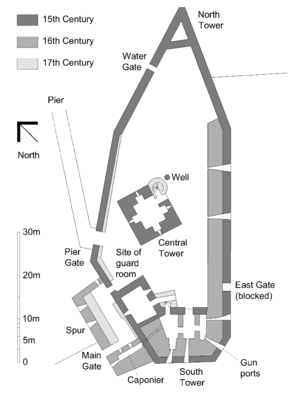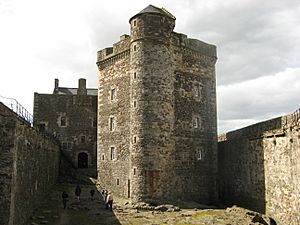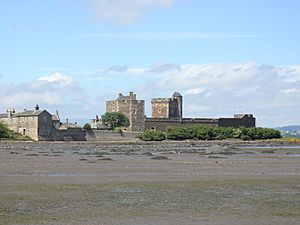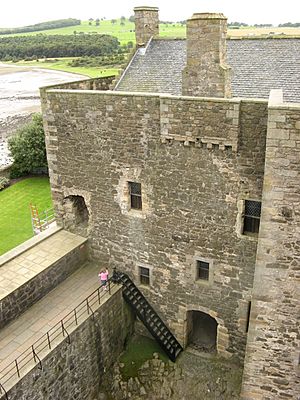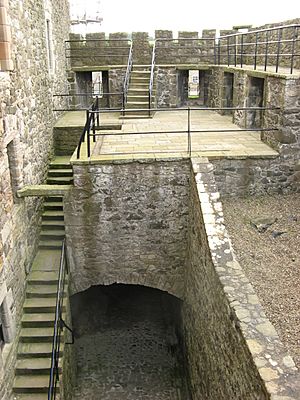Blackness Castle facts for kids
Quick facts for kids Blackness Castle |
|
|---|---|
| Blackness, Falkirk, Scotland NT055802 |
|
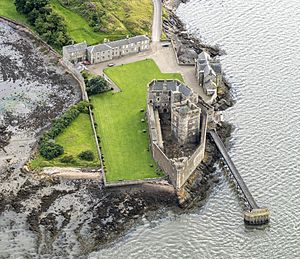
Aerial photo of Blackness Castle
|
|
| Coordinates | 56°00′22″N 03°30′58″W / 56.00611°N 3.51611°W |
| Type | Curtain wall, artillery fortification |
| Site information | |
| Owner | Historic Environment Scotland |
| Open to the public |
Yes |
| Condition | Restored |
| Site history | |
| Built | 1440s |
| Built by | Sir George Crichton |
| In use | Until 1912 |
| Materials | Stone |
Blackness Castle is a strong fortress from the 15th century. It stands near the village of Blackness, Scotland. The castle is on the south shore of the Firth of Forth, which is like a wide river mouth.
It was likely built by Sir George Crichton in the 1440s. Blackness was then the main port for Linlithgow. Linlithgow was an important town and a home for Scottish kings and queens. In 1453, the castle became property of James II of Scotland. It has been a royal castle ever since. It was used as a state prison for important people. These included Cardinal Beaton and the 6th Earl of Angus.
Sir James Hamilton of Finnart made the castle stronger in the mid-1500s. It became one of Scotland's best castles for defending against cannons. But in 1650, these defenses were not enough. Oliver Cromwell's army captured Blackness. After the attack, the castle was fixed up. It was used again as a prison and a small army base. In 1693, parts of the castle were changed to hold heavy guns. From the 1870s until 1912, it was an ammunition depot. This means it stored weapons and gunpowder. The army used it briefly during World War I. Today, Historic Environment Scotland looks after it. It is a protected historic site.
Because it sticks out into the Forth and has a long, narrow shape, people call it "the ship that never sailed." The towers are even named "stem" and "stern," like parts of a ship. The middle tower is called the "main mast."
Contents
Blackness Castle: A Fortress on the Forth

A Look Back in Time
In the mid-1400s, Sir George Crichton owned the land of Blackness. He was a powerful Scottish leader. The Crichton family was very important at that time. They were close to King James II. The castle was probably built in the mid-1440s. This was when the Crichtons were fighting with another powerful family, the "Black" Douglases.
Blackness Castle is first mentioned in records in 1449. It was already a prison for important people. It was also Crichton's home. The first castle had a strong outer wall and a north tower. The central tower stood alone in the middle. A large hall might have been to the south. A ditch cut into the rock protected the castle. The main gate was on the east side.
In 1453, George Crichton gave Blackness Castle to King James II. Crichton's son, James Crichton, tried to take the castle back. But the King quickly took it back the same year. Blackness then became a royal castle. It continued to be a prison. A "keeper" was put in charge of the castle.
King James IV visited Blackness on July 11, 1506. He came after visiting the Isle of May by ship. In November 1512, two large warships, the Great Michael and the Margaret, were at Blackness. King James IV met with the French ambassador on the Michael. They confirmed the friendship between Scotland and France.
In the 1600s, the Livingstone family became the permanent keepers of Blackness Castle.
Strong Defenses
Between 1534 and 1540, the castle was made much stronger. This work was led by Sir James Hamilton of Finnart. He was the King's Master of Works. Finnart was an expert in building castles to defend against cannons. He had studied castle design in Europe. He even designed his own castle, Craignethan, to show his ideas.
At Blackness, he added new features. One was a special entrance with a "caponier." This was a passage inside the outer wall of the entrance. It allowed defenders to shoot at attackers who got past the first gate. The outer wall was also made much thicker. It went from about 1.5 meters (5 feet) to over 5 meters (16 feet) thick in some places. New openings for cannons were also added. The south wall was made taller to protect the new south tower.
Work continued after Finnart was executed in 1540. The "dungeon" (main tower) and kitchen towers got new roofs. Major building work stopped in 1542 when King James V died. In 1547, English ships attacked Blackness. They captured some Scottish ships and burned others.
During a time of religious change in Scotland, the castle was given to James Hamilton, Duke of Châtellerault. Two English captains then took control in April 1560.
Castle Under Siege
During a civil war after Mary, Queen of Scots gave up her throne in 1567, Blackness Castle stayed loyal to her. But the keeper, Alexander Stewart, later joined the other side. In 1572, Lord Claud Hamilton took the castle back for Queen Mary. He attacked ships in the Forth. In January 1573, James Kirkcaldy arrived from France with weapons and money for Queen Mary's side. His ship was captured the next day. The castle surrendered within a week.
In 1580, Malcolm Douglas gave the castle to Lord Robert Stewart. The castle's defenses were not tested again until 1650. This was when Oliver Cromwell's army attacked Blackness. By this time, cannons were much more powerful. The castle's old defenses could not hold up. The soldiers inside quickly gave up after being attacked from land and sea. The damaged castle was then left empty.
Later Years and Restoration
The castle was not fixed until 1667. It was used as a prison again. It held "Covenanters," who were religious rebels. The south tower was changed. A new stair tower was added. More changes were made in 1693. The north tower was made shorter to hold three large cannons. These cannons looked out over the Forth.
After Scotland and England joined together in 1707, Blackness stopped being a prison. It became one of four Scottish castles kept by the British Army. The others were Stirling, Dumbarton, and Edinburgh. About fifteen soldiers lived at Blackness in the late 1700s. From 1759 to 1815, Blackness was used as a prison again. It held French soldiers captured during wars like the Seven Years' War and the Napoleonic Wars.
In 1870, Blackness Castle's role changed again. It became the main place to store ammunition for Scotland. Many changes were made. The whole courtyard was covered with a roof. The ground to the east was made flat. The defensive ditch was filled in. Barracks (buildings for soldiers) were built to the south. A metal pier was built in 1868. It had a gate and a drawbridge. This was one of the last drawbridges built in Britain. The ammunition depot closed in 1912. The castle was briefly used again during World War I.
After that, the castle was taken care of by the Office of Works. A big project to restore the castle happened between 1926 and 1935. Most of the 19th-century changes were removed. Medieval-style parts were rebuilt. These might not be exactly how the castle looked originally.
Castle Features
The castle sits on a rocky piece of land in the Firth of Forth. It faces north and south. It has an outer wall with towers built into it, one to the north and one to the south. There is also a separate central tower inside the courtyard. To the southwest, a defensive "spur" forms the main entrance. A water gate to the northwest leads to the 19th-century pier. Outside the walls are barracks and officers' quarters from the 1800s.
North and South Towers
The small North, or "Stem," Tower originally had three floors. It was made shorter to two floors in 1693. The top room had a fireplace. The bottom room was a pit prison. You could only get into it from a trap-door above. This room had a drain to the sea, which would fill with water at high tide.
The South, or "Stern," Tower was mostly built in the mid-1500s. It might have replaced an older hall building. On the south wall, 16th-century stone was added on top of the older 15th-century battlements. This left a pattern of high and low sections in the wall. The tower is built over thick-walled cannon positions in the basement. These defended the south and east sides. The openings for the cannons are very wide, up to 1.5 meters (5 feet) across. The South Tower had the main living areas in the castle. It had rooms in the northwest part and a large hall on the top floor. This hall was divided when the castle was an ammunition depot. It has since been put back to how it was. In the 1600s, the large south-facing window was used as a place for a gun.
Central Tower
The five-story Central Tower, or "main mast," was built in the 1400s and made taller in the 1500s. It is about 11 by 9.8 meters (36 by 32 feet). Its walls are 2.3 meters (7.5 feet) thick at the bottom. Each floor has one large room with a fireplace. It also has a toilet and many small rooms inside the walls. The floors were first connected by a narrow spiral staircase. A larger stair tower was built in the 1600s.
The castle's most important prisoners were kept here. People like Cardinal Beaton and Archibald Douglas, 6th Earl of Angus would have lived quite comfortably. They even had their own servants while in prison. The basement has a curved stone ceiling. The roof is also made of stone. The top wall was rebuilt in the 1900s. There is a well outside the tower.
The Spur Entrance
The 16th-century "spur" is a special outer defense for the main gate. It was mostly built by Sir James Hamilton of Finnart. It has many defensive features. Originally, a rock ditch was in front of the entrance. A drawbridge crossed this ditch. The original iron gate from 1693 is still there.
Once through the entrance, an attacker would have to go through a winding passage. This would expose their back to fire from the caponier. Part of this passage could also be attacked from the wall-walk above. In the late 1600s, the spur was made taller. Cannon platforms were added on top.
Modern Use
Since the castle was restored, it has been open to the public. It is a historic monument. The castle buildings are empty inside. But there is a small exhibition in the old barracks outside. Blackness Castle has been used as a place to film movies and TV shows. These include Hamlet (1990) and Doomsday (2008). On TV, it has been in Ivanhoe (1997) and Outlander. It was also used for the BBC Scotland series "Rise of the Clans."
See also
 In Spanish: Castillo de Blackness para niños
In Spanish: Castillo de Blackness para niños


